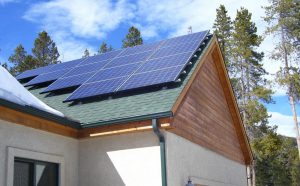The Best 5 Seasonal Solar Maintenance Tips
The Best 5 Seasonal Solar Maintenance Tips
Article Author: Meghan Harmon, Director of Marketing & Media
The changing of the seasons means a lot of things for families when it comes to home maintenance: preparing the house for holiday guests, raking leaves, cleaning out rain gutters, and stocking up on winter supplies. But for solar customers, it should mean a few extra things be added to your checklist in order to avoid future production issues. Many people forget that failing to check-in on your system up top once in awhile may result in costly repairs and high energy bills due to lost production. Here are a few things you can do to care for your solar system during seasonal changes.
(1) Clear Fall Debris & Build up
I think we all know what the changing of the seasons means in terms of yard work – cleaning up leaves and pine needles from your property. Other than being an unsightly addition to your roof, it’s best to clear any debris that has accumulated in your rain gutters. This in any easy way to avoid future issues, as buildup can encourage nesting of critters underneath your solar panels.
(2) Panel Cleaning
Cleanings are a very important, yet often overlooked factorwhen it comes to maximizing solar production. Power output can decrease as much as 30% when you have dirty panels, that could make the difference of offsetting your bill each month. It is best to have a minimum of two cleanings performed per year; one in Spring and Fall.
Panel cleanings are rarely performed in the winter months for a number of reasons. These include snow and ice, fallen branches, debris build up causing obstruction issues for the cleaning technician. Also, the combination of icy cold water and hot glass can sometimes cause panels to crack. Many people may think that the occasional occurrence of rain can wash away any debris build up on their system. However, experts found, “Rain is not a satisfying way of cleaning solar panels. Solar panels that were cleaned professionally had a 12% higher output of electricity compared to those cleaned by rain” (Maehlum, 2013). Depending on the size of your home, that could have a significant impact on your energy bill each month.
(3) Routine Inspections
The best time to get your panels looked at is right before winter hits. If there are any underlying issues, it is better that they are identified and fixed before weather becomes a factor in scheduling an inspection. Our team recommends that a professional take a look at your system at least twice a year. This is to ensure that your panels are in good condition and they there are no issues when it comes to wiring or connectivity.
Our sister company Solar Maintenance Pros performs a visual inspection along with each panel cleaning. They have come up with a list of important points to hit in their inspection report such as: roof damage analysis, obstructions on or near panels, and a report of system’s overall condition. If there happens to be any problems with your system, they will address them and find affordable solutions on how to get them fixed.
(4) Let Weather Work Itself Out
Since we haven’t seen snowfall in Fresno since 1998, I think it is safe to say you don’t need worry about snow covering your panels unless you live in the foothills. However, ice and frost can also become an issue as we head into the colder months of the year. The best solution is to leave panels as there are, because the dark cells will encourage it to melt once the sun comes out.
Attempting to scrape off or rake snow and ice off your panels can result in damage to the solar cells. It is also a very dangerous time of the year to be up on a roof, so hang your Christmas lights with caution!
(5) Don’t Stress Over Production
You should be aware that your solar production will dip during the winter months, but don’t fret. Solar customers will have lower production months; your sales consultant designed your system to account for your total annual usage. You will produce more during the summer months and less during winter. At the end of the year, your TrueUp bill should account for your total energy usage.
I n late fall and early winter, days are are cold but sunny. This can actually mean higher performance and efficiency. The Central Valley’s intense summer heat is hard on your solar equipment, causing efficiency to drop off in extreme temperatures. “Yes, panels will perform better in cooler temperatures, but they’re not big fans of snow storms, either. Snow or ice sitting on the surface of your panels obviously limits production, since the cells can’t absorb the sunlight under these conditions”(modernize.com).
n late fall and early winter, days are are cold but sunny. This can actually mean higher performance and efficiency. The Central Valley’s intense summer heat is hard on your solar equipment, causing efficiency to drop off in extreme temperatures. “Yes, panels will perform better in cooler temperatures, but they’re not big fans of snow storms, either. Snow or ice sitting on the surface of your panels obviously limits production, since the cells can’t absorb the sunlight under these conditions”(modernize.com).
Nonetheless, winter months do have shorter days with fewer sunlight hours. Meaning, you are likely to produce less overall energy so remember not to stress. Grab a cup of hot cocoa and snuggle up by the fire with a loved one!
If you are concerned with ways to save energy as we head into the lower-production months, check out these nifty tips from Wholesale Solar. Consider these energy saving tips to make the most of your clean electricity:
1. Ensure that your house has proper insulation to conserve heat. If not, investigate the cost of adding insulation to exterior walls and attic.
2. Before turning on your heater, check your ducts for leaks.
3. Use a heating system that automatically maintains a preset temperature with the help of a digital thermostat.
4. Make sure to close your damper when the fireplace is not in use.
5. Take advantage of sunny days to heat your house.
6. Open the curtains on your south-facing windows during the day and close them at night to lock the warmth in. Thermal curtains help insulate windows even better than regular curtains.
7. Make sure you only use necessary loads.
8. Turn off excessive lighting when not needed.
9. Disconnect ghost loads that consume power even when off as long as they are plugged in. Over a period of 24 hours, a plugged in TV consumes the same power as when it is ON for thirty minutes.
10. Replace all the high wattage bulbs with energy efficient ones. You could save about 75% of energy consumed by a 60 watt bulb by replacing it with a 15 watt energy efficient CFL, without sacrificing your light output.
https://blog.wholesalesolar.com/winter-maintenance-tips-solar-systems/




 n late fall and early winter, days are are cold but sunny. This can actually mean higher performance and efficiency. The Central Valley’s intense summer heat is hard on your solar equipment, causing efficiency to drop off in extreme temperatures. “Yes, panels will perform better in cooler temperatures, but they’re not big fans of snow storms, either. Snow or ice sitting on the surface of your panels obviously limits production, since the cells can’t absorb the sunlight under these conditions”(modernize.com).
n late fall and early winter, days are are cold but sunny. This can actually mean higher performance and efficiency. The Central Valley’s intense summer heat is hard on your solar equipment, causing efficiency to drop off in extreme temperatures. “Yes, panels will perform better in cooler temperatures, but they’re not big fans of snow storms, either. Snow or ice sitting on the surface of your panels obviously limits production, since the cells can’t absorb the sunlight under these conditions”(modernize.com).
Leave Comment